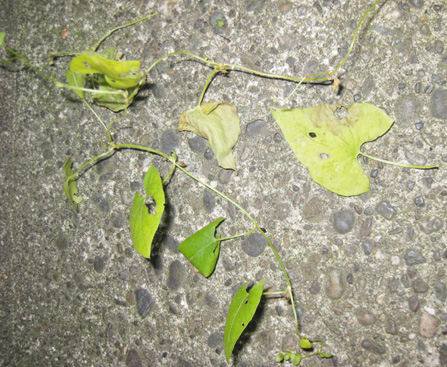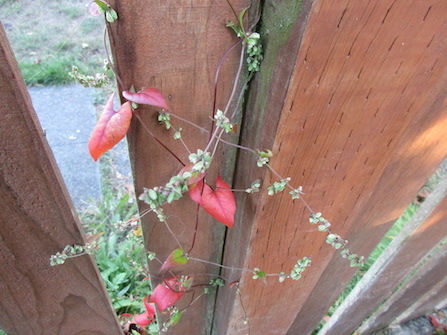
|

|
| Black Bindweed; Polygonum Convolvulus L. |
Buckwheat Family; POLYGONACEÆ
|
| Black Bindweed is like a shadow of our ubiquitous Wild Morning-Glory (Weed of the Month July 1987). Less showy, less common, less obnoxious, and
comparatively unimportant, it still can be nearly as interesting. |
| Although fascinatingly alike in its arrowhead leaf shape, and in being a weedy vining plant from the Old World, it is unrelated to
the Morning Glory family. Instead it is in the Knotweed clan, which includes Creeping Knotweed, Silver Lace Vine, Bistort, Lady's
Thumb, Docks, Sorrels, and Buckwheat. |
| Some alternate names for Black Bindweed are: Climbing or Ivy Knotweed, Cornbind, Bearbind, Devil's Tether, and Wild
Buckwheat. No better way to make it familiar than to compare it to common wild Morning Glory. The Morning Glory is a perennial with plump,
far-reaching white roots; Black Bindweed is a summer annual with tough, slender yellow or brownish roots. Morning Glory chokes
tightly and its stem exude a sticky white juice when wounded. Black Bindweed climbs loosely in a relaxed, almost languid manner, and has
no milky juice. Morning Glory has showy, large white bell flowers glorious in the morning, but setting few seeds; Black Bindweed
bears numerous tiny flowers, dingy and always unnoticed, making copious seeds. My fall color picture above shows the seeds well. |
| In brief, Black Bindweed is a smaller, seedy plant, not such an insatiable smothering curse. It is also found chiefly on
disturbed soil, in the sun, whereas Morning Glory can grow anywhere. The valuable Buckwheat plant is only a few genes removed from Black
Bindweed, being more upright, making pretty white flowers, and seeds twice as large, otherwise is passably similar. It is the
seeds that give this weed its name, for they are black, albeit encased in thin sheaths that change from pale green to brown. Each seed is triangular, about a sixth
of an inch long, and packed with starch. If people gathered enough, a grain could be had. But it is not worthwhile. |
| The leaves are generally more sharply pointed than those of Morning Glory, as well as firmer in texture, but can also be
pleasantly rounded and wide like a kidney bean shape; the largest are about 4 inches long. Also, minute examination reveals fine hairs covering
the Black Bindweed foliage. The leaf flavor is ever so mildly sour, and tender tips are agreeable added sparingly to salads. |
Most gardeners who have yet to learn it intimately probably pass it by as a degenerate seedling Morning Glory. Knowing it better
makes one judge it an ugly seedy sprawling plant that is not a serious garden pest, but is neither a weed to tolerate: yank it up. Grow the
real Buckwheat if you like, not this wildling whose mission in life seems to be seed-production.
|
Originally published as the Seattle Tilth newsletter Weed of the Month in October 1991, along with a photocopied plant.
Back |
|
|

